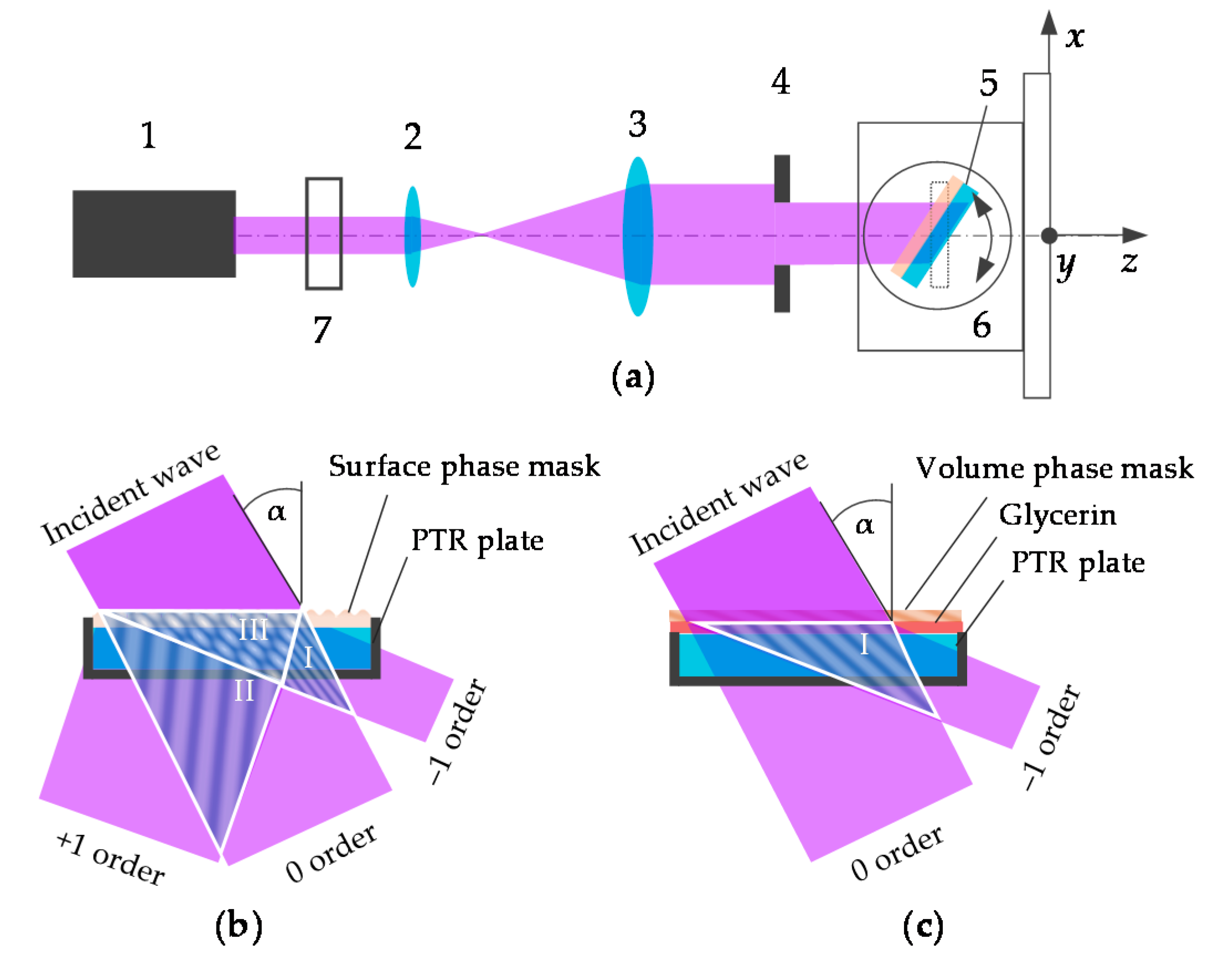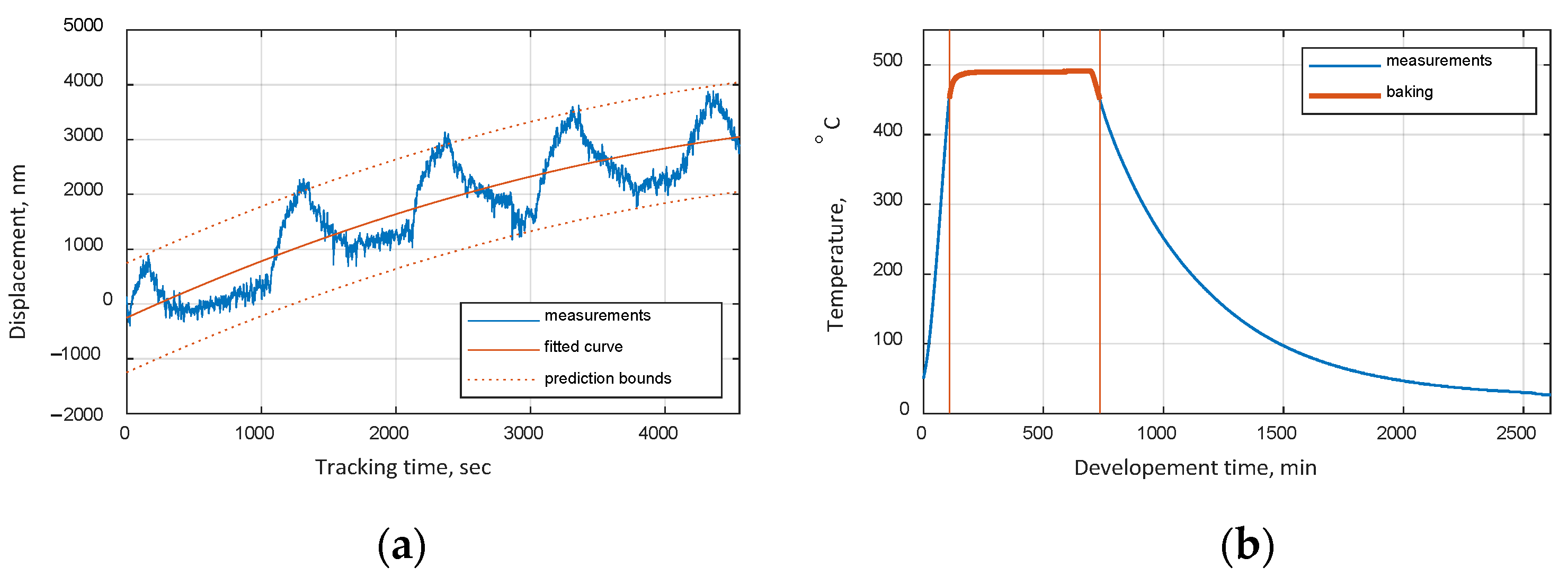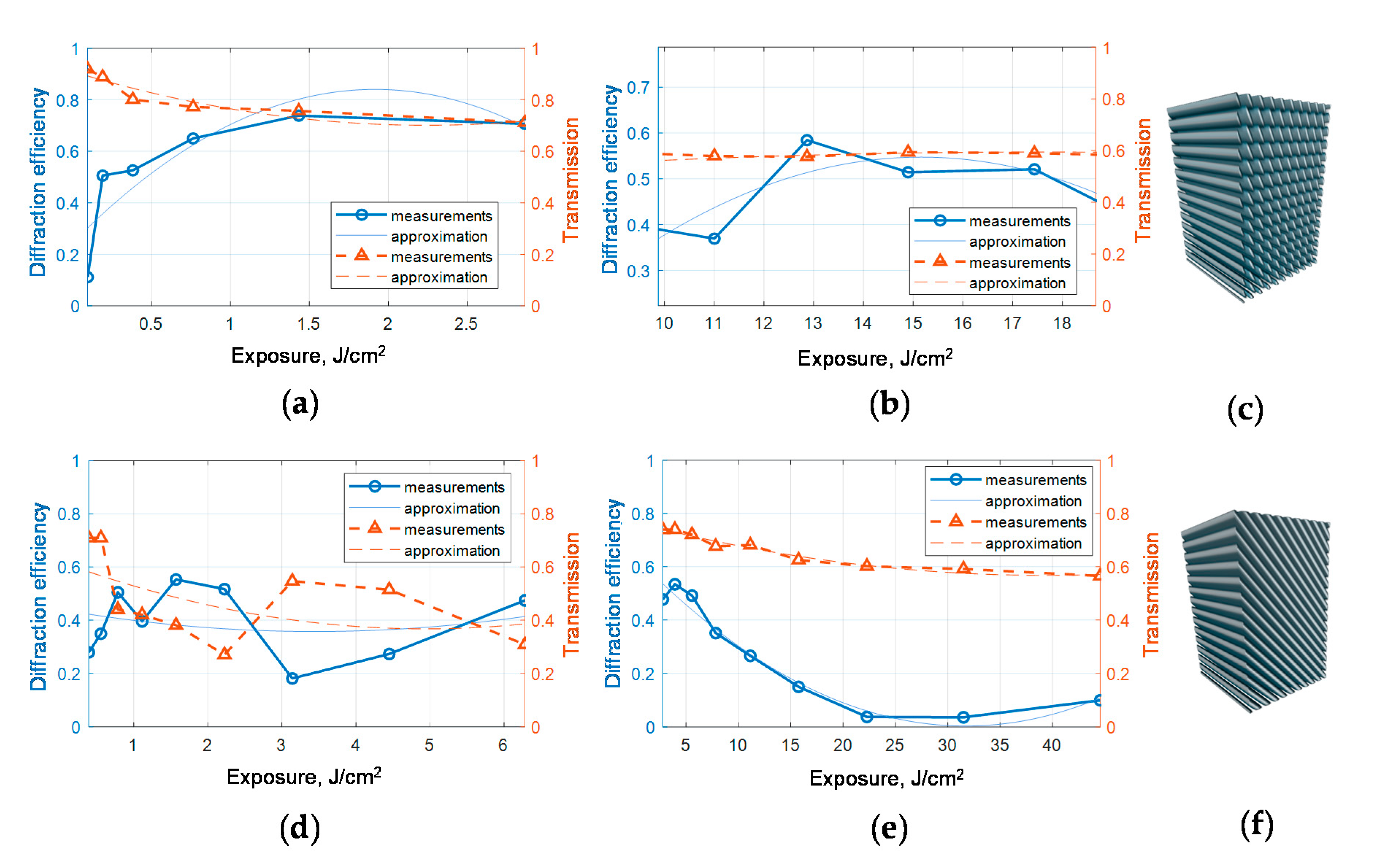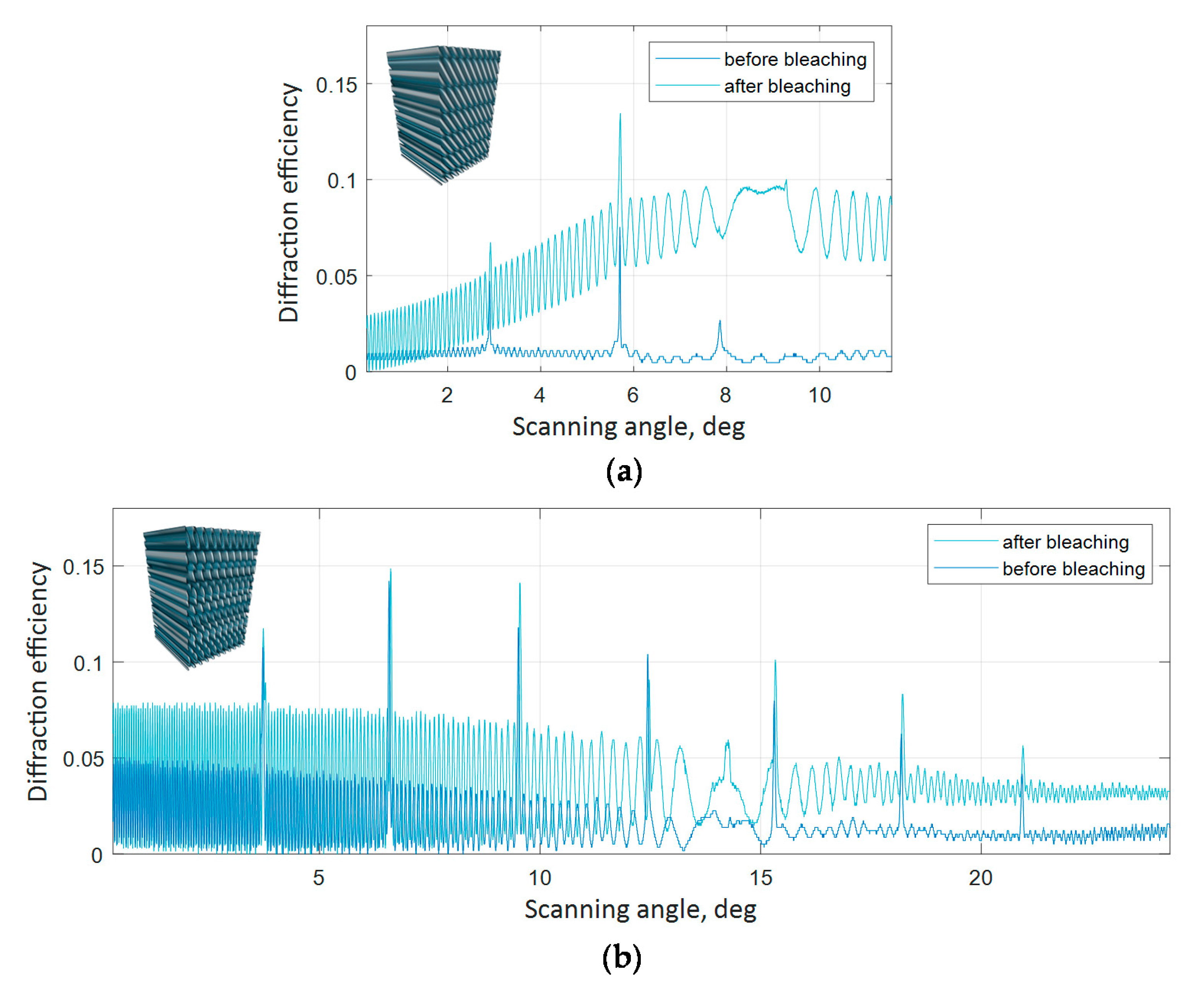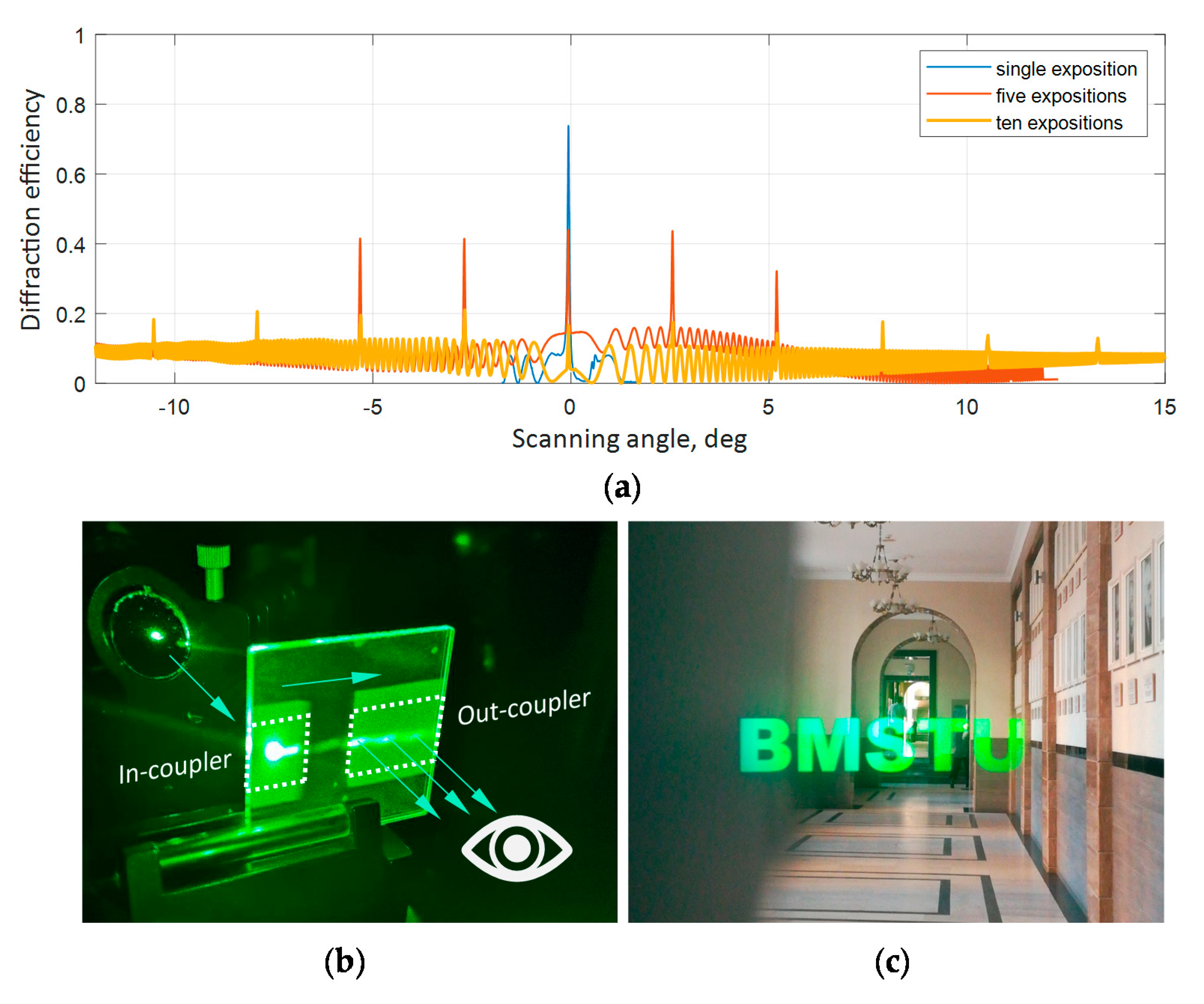1. Introduction
With the development of augmented reality (AR) [
1,
2] and integrated photonics devices [
3], researchers are faced with the task of developing new methods for waveguide holograms recording and creating the diffraction waveguides. In the field of AR displays, diffraction waveguides are the plane-parallel substrates combined with the diffraction gratings that provide substrate-mode propagation of diffracted beams with the help of total internal reflection (TIR). The diffraction grating can be surface or volume one but diffraction angle inside the substrate must satisfy TIR condition. Bragg holographic gratings are commonly used for the grating-based waveguide configurations to increase the optical efficiency of AR systems [
4,
5]. Corresponding recording is associated with increasing the complexity level since large convergence angles of the recording beams must be provided. An object wave must be inside the substrate during recording. In this paper, a method for multiplex recording of Bragg diffraction waveguide gratings is proposed. Presented waveguides refer to AR planar imaging optics used for radiation coupling into a glass plane-parallel plate.
AR implementation under study includes multiplexed space variant elements and requires holographic materials with good refractive index modulation properties. In the research, the planar waveguides rely on photo-thermo-refractive (PTR) glass as a holographic volume media. This material is unique for the integration of a phase diffraction elements into the waveguide platform [
6]. PTR glass is good material for see-through displays because avoids various problems when exposed to environmental perturbations such as temperature, humidity and pressure, and close to optical glass BK7 by the properties [
7]. The glass substrate is the holographic material itself so we can record holograms over the entire thickness of the substrate. The good advantage of PTR glass for holography is the absence of shrinkage.
Creation of the waveguide mode multiplexed Bragg gratings in the planar waveguide made from PTR glass is a challenge of the research. We propose a recording method using the phase mask and oblique illumination. This technique is stable and convenient to fabricate high resolution volume diffraction gratings [
3,
8,
9,
10,
11] with waveguide mode operation. Presented research is distinguished by oblique illumination of the phase mask with a single recording laser beam to manufacture the slant volume gratings for AR waveguide displays. Conventional phase mask techniques provide recording of the structure with isophase fringes perpendicular to the substrate surface. With such a limitation, it is impossible to create AR waveguides, since their functioning directly depends on the direction of the diffraction structure relative to the substrate surface. The oblique illumination of the proper phase mask allows us to record the slant gratings working in the waveguide mode. The paper considers two types of the phase mask: non-selective surface diffraction gratings and selective volume diffraction gratings. To provide recommendations for their applicability, the comparison is carried out based on diffraction characteristics of manufactured single and multiplexed Bragg gratings. To confirm the efficiency of the proposed method, the diffraction waveguide was successfully fabricated and integrated in see-through AR display.
2. Principles
The recording though the phase mask has a number of advantages over the standard interferential recording set up, which implements an amplitude division interferometer. There are several arguments in favor of the phase mask application independent from its type. To provide high frequencies of Bragg gratings, large convergence angles of the recording beams are required [
12]. This is easier to implement with a diffraction grating as the phase mask, whereby convergence angles are diffraction angles. Flat uniform wavefront must be created for only one branch. In the described experiment, volume gratings were manufactured in a wide beam of at least 50 mm in aperture. The entire area of the diffractive waveguide was recorded at the same time. The creation of this size uniform plane wavefront becomes a nontrivial task for UV light. Requirements for a vibration stabilization of the recording set up were significantly reduced. Due to the fact that the sample and the phase mask are combined into a single structure; the mechanical vibrations occur relative to the sandwich from the phase mask and the photosensitive PTR substrate. The interference pattern is not getting shifted during the recording due to the vibrations. It is necessary to stabilize the relative displacement of the mechanical components in the scheme only in one branch, which is beneficial for long-term exposures.
This section describes in detail a general guideline for the recording though the surface and volume phase masks with multiple sequential exposures.
Figure 1a illustrates the scheme of the recording set up. The proposed recording method applies the diffraction grating as the phase mask to create a near-field interference pattern in the photo-thermo-refractive substrate. The energy distribution in diffraction orders of the phase mask is responsible for the recording contrast.
Single coherent beam illuminates the phase mask and forms superimposing beams in the diffraction orders, the phase mask gets replicated to the thick-layer holographic material. This method is also called holographic or optical replication [
13,
14], especially if the recording laser wavelength during the replication is the same as when recording the phase mask. Radiation with the wavelength of 0.325 μm (He-Cd laser
1) is expanded and collimated using lenses
2 и
3 as a telescopic Kepler system. A diaphragm
4 cuts the central part of the recording beam with the satisfactory uniformity of the radiation intensity. The sandwich of phase mask and PTR glass substrate
5 is mounted on a motorized angular positioner
6 that controls an angle of incidence α. Coherent plane wave falls onto the one-dimensional grating (phase mask) first, a plane of incidence is normal to the grooves of the phase mask. The exposing area in the recording beam is controlled by the displacement in the
xy plane. The entire recording procedure with the necessary angular and planar positions is carried out using programmed control of the actuators in the recording setup. The exposure dosage is provided by an electromechanical shutter
7.
Figure 1b,c represents the near-field recording areas formed after surface and volume gratings, respectively. The phase mask must be directly applied to the waveguide or must be adjacent through an immersion liquid in order to correctly implement the conditions for large convergence angles. Diffraction on the non-selective surface grating (
Figure 1b) as the phase mask results in three beams propagating inside the PTR glass substrate: transmitted beam (0th diffraction order) and two diffracted beams (+1st and −1st orders). Therefore, three interference areas are formed in te PTR glass substrate: the area
I corresponds to interference of +1st and 0th diffraction orders, the area
II with interference of 0th and −1st diffraction orders and the area
III with interference of all three +1st, 0th, and −1st diffraction orders.
Figure 1b illustrates a geometrical representation. In practice, the area
III occupies most of the recording volume due to relatively small waveguide thickness (2 mm), in comparison with the aperture of the recorded beam (40 mm). The interference pattern of the area
III fills the full thickness of the holographic material. The size of the recording beam is chosen so that its aperture is sufficient to fill the entire required area of the final diffraction element. Still non-uniformity can impact the diffraction efficiency. The following experiments represents the resulting performance that can be achieved. Diffraction on the selective volume grating (
Figure 1c) as the phase mask results in two waves that are propagating inside the PTR glass substrate: transmitted wave (0th order) and diffracted wave (−1st order). The operating periodicity of the diffraction waveguide is formed by the interference of 0th and −1st diffraction order, which is included in the areas
I and
III.
The waveguide couplers for AR displays consist of several multiplexed volume Bragg gratings.
Figure 1 represents a single exposure step. The experimental task of multiplexing procedure is to use effectively the refractive index modulation, which is responsible for the entire dynamic range.
4. Discussion
The multiplexed recording through the phase mask in PTR glasses was carried out in the research. In the course of the study, a comparison was made between two types of phase masks: the surface non-selective phase mask and the volume selective phase mask. The design of the phase mask itself is not the item of the research presented. It is based on a diffraction equation and starts with the periods and slant angles of the Bragg grating that needs to be achieved [
6].
Multi-exposure approach is analyzed to balance the angular bandwidth and diffraction efficiency of the resulting volume diffraction elements. The multiplexing helps to expand the effective angular field of view in near-eye displays. The structural parameters for each multiplexed grating are optimized to the propagation direction. The space multiplexing varies the slant angles of the volume Bragg grating in the diffraction couplers. The presented procedure is more feasible for the application of the surface phase mask. Rearrangement of the interference recording set up for a wide range of multiplexing angles is complicated. However, having recorded the phase mask once and performing the replication procedure, we rotate only one component in the recording beam. When recorded in the photoresist, the surface phase mask can be applied directly to the PTR glass plate. PTR glass is not photosensitive to radiation, which is actinic for the photoresist. In the other case, the selective phase mask is no longer applied for angular multiplexing; thus, it is necessary to replace the phase mask for each following multiplex and, accordingly, make as many masks as necessary for multiplexing. Additionally, for each exposition step we need to use immersion liquid. The selective phase masks presented in this research were made from dichromated gelatin.
It was expected that the application of Bragg grating as the phase mask would lead to more efficient refractive index modulation of the medium, whereby it was possible to achieve equalization of the diffraction efficiency in two orders. Nevertheless, the difficulties associated with the immersion liquid application and docking of the various selective masks complicate the process and have a destructive effect. During the experiment, it was not possible to achieve positive results in multiplexing using the selective phase masks due to the increase in the technological complexity.
The surface phase mask provides quality multiplexed recording despite the inequality of diffraction efficiency in the orders. This type masks shows the same results in exposure dosages as Bragg phase masks, but their application is more convenient due to the free control of the recording beam angle due to the non-selectivity. The holographic replication of the surface phase mask is the suitable recording method for multiplexed slanted volume diffraction gratings.
Presented method reduces the period of the recorded optical phase structures by 1.5 times in comparison with the period of the phase mask and shows the high level of repeatability. This recording technique is accompanied with no need in the strong vibration isolation because of the absence of the interferometric branches in the optical scheme. The presented method can be applied to Bragg grating recording in optical fibers. PTR glass helps to integrate thick holographic grating inside the planar dielectric substrate. The recorded multiplexed volume gratings can be tailored for the coupling functions for AR platform. The presented example of the waveguide for the near-eye display demonstrates the operability of multiplex diffraction elements recorded using the technique under study.
